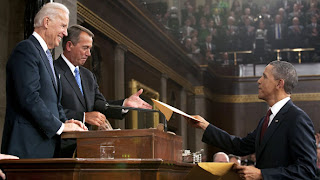Comments:
Below is the full text of President Obama's 2012 State of the Union address.
Mr. Speaker, Mr. Vice President, members of Congress, distinguished guests, and fellow Americans:
Last month, I went to Andrews Air Force Base and welcomed home some of our last troops to serve in Iraq. Together, we offered a final, proud salute to the colors under which more than a million of our fellow citizens fought – and several thousand gave their lives.
We gather tonight knowing that this generation of heroes has made the United States safer and more respected around the world. For the first time in nine years, there are no Americans fighting in Iraq. For the first time in two decades, Osama bin Laden is not a threat to this country. Most of al Qaeda’s top lieutenants have been defeated. The Taliban’s momentum has been broken, and some troops in Afghanistan have begun to come home.
These achievements are a testament to the courage, selflessness, and teamwork of America’s Armed Forces. At a time when too many of our institutions have let us down, they exceed all expectations. They’re not consumed with personal ambition. They don’t obsess over their differences. They focus on the mission at hand. They work together.
Imagine what we could accomplish if we followed their example. Think about the America within our reach: A country that leads the world in educating its people. An America that attracts a new generation of high-tech manufacturing and high-paying jobs. A future where we’re in control of our own energy, and our security and prosperity aren’t so tied to unstable parts of the world. An economy built to last, where hard work pays off, and responsibility is rewarded.
We can do this. I know we can, because we’ve done it before. At the end of World War II, when another generation of heroes returned home from combat, they built the strongest economy and middle class the world has ever known. My grandfather, a veteran of Patton’s Army, got the chance to go to college on the GI Bill. My grandmother, who worked on a bomber assembly line, was part of a workforce that turned out the best products on Earth.
The two of them shared the optimism of a Nation that had triumphed over a depression and fascism. They understood they were part of something larger; that they were contributing to a story of success that every American had a chance to share – the basic American promise that if you worked hard, you could do well enough to raise a family, own a home, send your kids to college, and put a little away for retirement.
The defining issue of our time is how to keep that promise alive. No challenge is more urgent. No debate is more important. We can either settle for a country where a shrinking number of people do really well, while a growing number of Americans barely get by. Or we can restore an economy where everyone gets a fair shot, everyone does their fair share, and everyone plays by the same set of rules. What’s at stake are not Democratic values or Republican values, but American values. We have to reclaim them.
Let’s remember how we got here. Long before the recession, jobs and manufacturing began leaving our shores. Technology made businesses more efficient, but also made some jobs obsolete. Folks at the top saw their incomes rise like never before, but most hardworking Americans struggled with costs that were growing, paychecks that weren’t, and personal debt that kept piling up.
In summary;
In summary;
- • Extend the payroll tax cut and unemployment for rest of year. The White House and congressional leaders area on record in support of extending these benefits beyond the current Feb. 30 cutoff – a must-do for lawmakers in a critical election year.
• Create a trade enforcement unit that will bring together resources and investigators from across the federal government to go after unfair trade practices in China and other countries around the world. The government would also step up trade inspections to stop counterfeit, pirated or unsafe goods before they enter the United States. (Obama has ordered this.)
• Promote clean energy policies by ordering the Navy Department to make the largest renewable energy purchase in history – one gigawatt – and by directing the Interior Department to permit 10 gigawatts of renewable energy projects on public lands by the end of the year, enough to power three million homes.
• Create a Financial Crimes Unit within the Justice Department to go after large-scale financial fraud so that Americans’ investments are protected. (Obama has ordered this.)
• An executive order to clear away the red tape on many construction projects.
• An executive order to clear away the red tape on many construction projects.
These are the likely candidates.
Austerity will lead to this...








